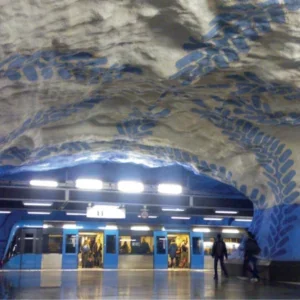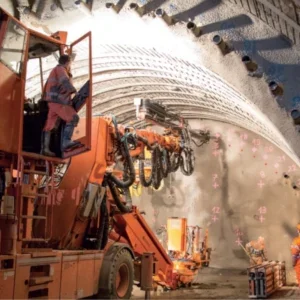Finsbury park is a major transport interchange station outside of Zone 1, and following the major’s strategy to improve accessibility of the underground network, it was earmarked as one of the stations requiring a step free upgrade. Additionally, the opportunity arose to combine step free access with the construction of a new western station entrance associated with a major development.
The initial concept design was completed in 2006. However, due to the change in priorities in the business, the project was put on hiatus until recent years when the concept design was revisited and developed to produce a contract package for tender as a design and build. The contract was awarded in June 2015 to Spencer’s Limited with Alan Auld Engineering, (now merged with Golder), as design engineers and Galldris as the tunnel construction sub-contractor. Finsbury Park is located in North London and is bounded by Seven Sister’s Road and Stroud Green Road. It is constrained by two bus stations; one at Station Place and one at Wells Terrace. The station is on three levels: the above street level for Network Rail, located approximately 7m above street level; the street level dedicated to buses and access to the station and the subsurface for the London Underground platforms at approximately 6m below street level.
The Network Rail platforms are built on an earthfill embankment. Site nvestigations carried out in 2006 showed the ground to comprise reworked London Clay overlaying London Clay. The Network Rail station has undergone changes over the years and currently it comprises eight operational platforms. The London Underground tunnels first operated in Finsbury Park in 1904 and then further tunnels were added in 1906 to form part of the Piccadilly line, which was then extended in the early 1930s. Major changes were introduced to the station in the 60s with the construction of the Victoria Line and all the connections that were built to allow maximum number of interchanges.
Before the award of the contract there were three access routes to the station; Wells Terrace, Seven Sisters and Station Place.
From Wells Terrace and Seven Sisters passengers would enter via the ticket offices and travel by Passageway 1 to an area called the Tee Junction. From there they would follow Passageway 2 to access the Piccadilly and Victoria line through several staircases.
Station Place is the most widely used entrance, which also provides access to Network Rail via Passageway 4 and up a series of stairs to Passageway 3. Passageway 4 also provides connection to Passageway 2 from where the Picadilly and Victoria lines can be reached.
The project requirement was to provide a step free route from street level to the London Underground station platforms while minimising station disruption to customers and the operational railway.
The identified key stakeholders were the public, Network Rail and London Underground operational management and staff, TfL Surface Transport, London Boroughs of Islington and Haringey, Kone (Lift service providers), fit out contractor and the City North development, which were the developers to provide the North Station Entrance.
The Step Free Access scheme involved the construction of two new lift shafts, upper and lower lift lobbies and also the rebuilding of staircases to connect into London Underground station platforms.
It also involved the refurbishing of the existing Passageway 4 and also the extension of that passageway to connect into the new Western Station Entrance. Before the project, only a small percentage of Passageway 4 was in public use. The new scheme was to allow passengers to access via Station Place and into refurbished Passageway 4 and its extension to reach the upper lift lobbies and the lifts to the LU station platform tunnels. The Western Station entrance is being developed by Telford Homes and to provide this entrance, a portion of Passageway 1 from Wells Terrace to the Tee Junction had to be handed over and be permanently closed. The Wells Terrace entrance has been given over to TfL surface transport and it is operated by the bus operators.
The positioning of Lift Shaft 1 and Lift Shaft 3 has been dictated not only by the need to connect into the extended and refurbished Passageway 4 respectively, but also by the congested subsurface infrastructure. As the available space was insufficient to fit the required infrastructure the existing staircases 160/1 and 160/3 had to be demolished and replaced to modern codes for the construction of Lift Shaft 1 and Lift Shaft 3 respectively. The works were defined as safety critical due to the need to construct right underneath Network Rail operation and in between and adjacent to the London Underground platform tunnels.
DESIGN – CONCEPT, TENDER AND DETAILED DESIGN
The original concept design was carried out by Tubelines with further work developed by a number of different consultants. This original concept included a proposed methodology and sequence for constructing Passageway 4 tunnel using the pipe arch technique, which involved excavating two steel tube piled pits and installing horizontal steel tubes to form a pipe arch to support the tracks. The main excavation was then proposed to be done full face by installing the heavy steel frames to provide support to the steel tubes carrying the track loads. The lift shafts were to be sunk as small independent deep shafts from platform level and the stair tunnels were also proposed to be driven as declines from the platform using pipe arches as temporary support. Each operation was considered in complete isolation. Spencer engaged Alan Auld during the bid process as the tunnel design and construction sequence specialists to develop the complex detailed design and the construction methodology. This was carried out by using a holistic design approach in which the temporary and permanent works are progressed together into an integrated design.
There were many concerns associated with this project from the start related to ground movements and settlement due to the big excavations required adjacent to the mainline railway and London Underground infrastructure. The construction methodology and construction sequence were considered to be key to minimise these ground movements and to successfully and safely construct the works.
The review of the construction methodology carried out by Spencer and Golder showed that the worksites were very concentrated, with limited access and constrained by existing surface and sub-surface assets leading to complex 3D shapes required to connect the assets. Different alternatives were considered such as SCL, box jack, box slide and bulk excavation but they were soon ruled out due to the constraints, lack of space and being impractical for this site. The review concluded that sequential hand excavation using traditional steel and timber temporary works was considered the most pragmatic solution. Therefore, the Golder design approach was to utilise the original concept of the concrete encased steel frames to carry the long term ground loads. These steel frames are able to carry loads very early on in the process and installing square works is the easiest and quickest way to transfer those loads during construction. However, the original construction methodology was changed and simplified using small sequential excavations which would provide more control over ground movements and would be simpler to construct and greatly reduce the risk to the railway, the workforce and the public.
The original main steel piled temporary access pit for the Passageway 4 construction was extended to include Lift shaft 1 and the new stair tunnel and connections. The extended pit was then deepened to the LU tunnel horizon. The steel piles could only be installed down to a certain level due to the proximity to the LU tunnels and below that level excavation continued by hand excavation, using traditional steel and timber temporary support. This allowed all the lift shaft steel and stair permanent steel to be installed bottom up as a secondary activity in a design coordinated with the temporary works. For lift shaft 3 construction a similar approach was adopted.
The methodology adopted allowed simpler handling and installation of the steel frames with a gantry crane.
Due to the short time scale between contract award and construction, the design was broken down into smaller packages so that they could be progressively assured by both LU and Network Rail. The assurance process required the production of a Conceptual Design Statement (CDS) following LU requirements for the Permanent Works and Network Rail forms F002/F003 for the approval of the temporary works.
The project is essentially in London Clay all the way to the LU tunnel except from some ash at track level and the railway embankment which is in reworked clay. The design was carried out following the Eurocodes, Network Rail and LU Design Standards and considered train loads, ground loads and platform loads together and using all the information available from historical drawings, intrusive surveys and visual inspections undertaken on existing structures.
Ground movement predictions were carried out using Oasys Xdisp and Pdisp and Plaxis and the values used to assess the potential extent of damage to the Network Rail tracks, Network Rail platforms, Network Rail underground structures, LU platform tunnels and tracks and LU underground structures. During construction the measured movements were very close to the predictions.
For the construction of Passageway 4, the original pipe arch was replaced with track slabs installed under the down goods and down Moorgate tracks, carried out in a series of possessions during the early enabling works, in which concrete encased steel I beams were installed. This tracks slabs supported the railway at all times during construction. Then, all the tunnelling works were undertaken safely under the slabs as protection. Sequential excavation was used with stacked headings filled with concrete to support the track slabs. The main excavation was then carried out as heading and bench in safe conditions, inside these completed temporary works.
Lift shaft 1 is a complicated structure. During the construction because there was not much ground left there was a conscious decision to expose the back of the LU platform tunnel rings and support them with the steelwork shoes that transferred the load.
Lift shaft 3 is a more compact structure than lift shaft 1 and was constructed slightly differently. All the works were carried out from the operational platform without the benefit of the steel piled pit. Due to the LU running tunnels being more separated at this location the excavation down could be carried out without exposing the back of the rings and without the need for shoes on the permanent works to support the rings. As the construction of this structure followed the completion of Lift shaft 1, value engineering was applied based on the lessons learned from the first lift construction and the steel sizes were then reduced. Following the excavation of the pit, the next excavation stage reached the existing Passageway 4, which is an old brick structure in very poor condition. When the footings of the brick structure were exposed it was found that they were in a far worse condition than anticipated and therefore the underpinning that was carried out to strengthen the structure included steel members.
All the frames used for the works were composed of small pieces bolted together in sizes that could be managed by the gantry system and handled through very difficult logistics and access. All the temporary steel was removed and replaced by permanent steel in the way up the pit, as construction progressed. The connection of the stair tunnels to the existing brick cross passages was achieved with minimum removal of bricks with galvanised steel ribs as the strengthening system.
CONSTRUCTION AND LOGISTICS
The Finsbury Step Free Access Scheme was awarded to Spencer Group as a Design and Build NEC3 Option A contract for an approximate value of GBP 20M (USD 27M). This was the first tunnelling project with LU for Spencer Group, which was the preferred bidder due to the innovative design solution and their track record and extensive experience in delivering projects within a live Network Rail environment.
The site compound was located in a Network Rail Yard which was approximately 120m away from Lift shaft 1. Due to the congested nature of the site, the key to the project was to develop a solution which allowed for bringing materials in and out the area of the works and also to be able to gain access continuously and not just during engineering hours. This was achieved by closely working with Haringey and Islington Councils to obtain approval for implementing a one way system. This allowed the contractor to close part of the footpath and install a very narrow scaffold access between the two rail bridges which became the main access to the worksite.
Material movement was carried out with the use of track trolleys during daily rail line blocks and through the Network Rail tracks from the site compound to Lift Shaft 1 site and vice versa. For the construction of Lift Shaft 3 the access was through the main Network Rail Station entrance, which had to be strictly coordinated with Network Rail and LU operational staff. Platform 6 was shut for the construction of the lift. For material handling the one way system created for Lift Shaft 1 was utilised again with the installation of a loading deck and a hoist at the end of platform 6. This allowed the materials to be brought up to platform level and transported along the platform to the Lift Shaft 3 work area. The main shaft was served with a double hoist gantry crane.
The initial concept considered that concreting would take place during station closing hours from Station Place. This added significant risk to the construction programme and therefore an alternative was devised to install a concrete line between the two railway bridges next to the scaffold access which run along the wideway into all the worksites and allowed concreting to take place at any time. Real time monitoring of all the assets was carried out and the data was analysed daily against predicted movements and pre-established trigger levels. All the readings were within the predicted values and tolerances.
The construction commenced in November 2015 with a series of critical possessions in order to undertake enabling works which included sheet piling to support the cable troughs and platform 8 as well as the installation of precast track slab beams under both railway lines. In Christmas 2015, under a blockade, the piled pit was completed and the gantry crane erected above the work site. In January 2016 the sequential excavation of the pit commenced for Lift Shaft 1, split into seven benches. The first four benches were excavated by mechanical means while the bottom three had to be done by hand to expose the existing northbound staircase which had to be demolished in a sequential manner. Once the bottom of the pit was reached hand excavation continued in strips and benches exposing the Picadilly and Victoria running tunnels. The new northbound staircase was open to the public in February 2017.
For Passageway 4, following the installation of the track slab beams, a series of stacked headings were constructed, which effectively created an underground bridge and enabled the commencement of excavation of the main tunnel in three benches while both Network Rail, down goods and down Moorgate lines were running.
Lift Shaft 3 works were split into six phases. The main excavation was phase 2 and it was done in benches all the way to the bottom. Once the excavation was complete and all the temporary works were installed, the permanent works installation could commence.
Unlike the Lift Shaft 1, the permanent works in Lift Shaft 3 were not acting as temporary works and they had to be fed through the temporary struts. Following the completion of phase 2, phase 3 commenced which involved the underpinning of Passageway 4 in order to dig further down for Phase 4 and access the lower part of the staircase, construct the Lower Lift Lobby followed by the connection to the existing 2/203 cross passage. Finally Phases 5 and 6 were the connections to the top of the stairs and Passageway 4.
The connection with Crosspassage 2/204 is currently under construction and will be completed this year.






